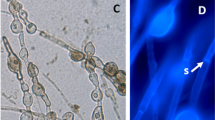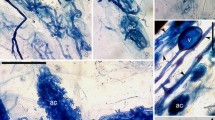Abstract
Native grasses of semi-arid rangelands of the southwestern USA are more extensively colonized by dark septate endophytes (DSE) than by traditional mycorrhizal fungi. Roots of dominant grasses (Bouteloua sp.) native to arid southwestern USA rangelands were prepared and stained using stains specific for fungi (trypan blue) and for lipids (sudan IV). This revealed extensive internal colonization of physiologically active roots by atypical fungal structures that appear to function as protoplasts, without a distinguishable wall or with very thin hyaline walls that escape detection by methods staining specifically for fungal chitin. These structures were presumed to be active fungal stages that progressed to form stained or melanized septate hyphae and microsclerotia characteristic of DSE fungi within dormant roots. The most conspicuous characteristic of these fungi were the unique associations that formed within sieve elements and the accumulation of massive quantities of lipids. This interface suggests a biologically significant location for carbon transfer between the plant and fungus. The continuous intimate association with all sieve elements, cortical and epidermal cells as well as external extension on the root surface and into the soil indicates that they are systemic and considerably more prevalent than previously thought. A fungal network associated with a mucilaginous complex observed on the root surface and its potential role in root function in dry soil is discussed. It is suggested that those fungi that non-pathogenically and totally colonize plant cells be classed as systemic endophytic fungi (SEF). This would refine the broad designation of DSE fungi. The potential mutualistic benefit of SEF for native plants in arid ecosystems based on the extent of lipid accumulation and its apparent distribution is discussed.



Similar content being viewed by others
References
Bago B, Zipfel W, Williams RM, Jun J, Arreola R, Lammers PJ, Pfeffer PE, Shachar-Hill Y (2002) Translocation and utilization of fungal storage lipid in the arbuscular mycorrhizal symbiosis. Plant Physiol 128:108–124
Barrow JR, Aaltonen RE (2001) A method of evaluating internal colonization of Atriplex canescens (Pursh) Nutt. roots by dark septate fungi and how they are influenced by host physiological activity. Mycorrhiza 11:199–205
Barrow JR, Osuna P (2002) Phosphorus solubilization and uptake by dark septate fungi in fourwing saltbush, Atriplex canescens (Pursh) Nutt. J Arid Environ 51:449–459
Barrow JR, Havstad KM, McCaslin BD (1997) Fungal root endophytes in fourwing saltbush, Atriplex canescens, on arid rangelands of southwestern USA. Arid Soil Res Rehabil 11:177–185
Bevege DI (1968) A rapid technique for clearing tannins and staining intact roots for detection of mycorrhizas caused by Endogone spp., and some records of infection in Australian plants. Trans Br Mycol Soc 51:808–810
Brundrett MC, Piche Y, Peterson RL (1983) A new method for observing the morphology of vesicular-arbuscular mycorrhizae. Can J Bot 62:2128–2134
Clay K (1990) Fungal endophytes of grasses. Annu Rev Ecol Syst 21:275–297
Cousin MA (1996) Chitin as a measure of mold contamination of agricultural commodities and foods. J Food Prot 59:73–81
Czarnes S, Hallett PD, Bengough AG, Young IM (2000) Root-and microbial-derived mucilages affect soil structure and water transport. Eur J Soil Sci 51:435 -443
de Cano MS, de Mule MCZ, de Caire O Z, Palma RM, Colombo K (1997) Aggregation of soil particles by Nostoc muscorum Ag. (Cyanobacteria). Exp Bot 60:33–38
Gantar M, Rowell P, Kerby NW, Sutherland IW (1995) Role of extracellular polysaccharide in the colonization of wheat (Triticum vulgare L.). Biol Fertil Soils 19:41–48
Grayston SJ (2000) Rhizodeposition and its impact on microbial community structure and function in trees. Phyton (Horn, Austria) 40:27–36
Haselwandter K, Read DJ (1982) The significance of a root-fungus association in two Carex species of high-alpine plant communities. Oecologia 53:352–354
Henson JM, Butler MJ, Day AW (1999) The dark side of the mycelium: melanins of pathogenic fungi. Annu Rev Phytopathol 37:447–471
Jumpponen A (2001) Dark septate endophytes: are they mycorrhizal? Mycorrhiza 11:207–211
Jumpponen A, Trappe JM (1998) Dark septate endophytes: a review of facultative biotrophic root-colonizing fungi. New Phytol 140:295–310
Kohn L, Stasovski I (1990) The mycorrhizal status of plants at Alexandra Fiord, Ellensmere Island, Canada, a high Arctic site. Mycologia 82:23–35
Kormanik PP, Bryan WC, Schultz RC (1980) Procedures and equipment for staining large numbers of plant root samples for endomycorrhizal assay. Can J Microbiol 26:536–538
Money NP, Caesar-TonThat TC, Frederick B, Henson JM (1998) Melanin synthesis is associated with changes in hyphopodial turgor, permeability, and wall rigidity in Gaeumannomyces graminis var. graminis. Fungal Genet Biol 24:240–251
Newsham KK (1999) Phialophora graminicola, a dark septate fungus, is a beneficial associate of the grass Vulpia ciliata ssp. ambigua. New Phytol 144:517–524
North GB, Nobel PS (1994) Changes in root hydraulic conductivity for two tropical epiphytic cacti as soil moisture varies. Am J Bot 81:41–63
Parbery DG (1996) Trophism and the ecology of fungi associated with plants. Biol Rev 71:473–527
Phillips JM, Hayman DS (1970) Improved procedures for clearing roots and staining parasitic and vesicular-arbuscular mycorrhizal fungi for rapid assessment of infection. Trans Br Mycol Soc 55:158–161
Read DB, Gregory P, Bell AE (1999) Physical properties of axenic maize root mucilage. Plant Soil 211:87–91
Roberson EB, Firestone MK (1992) Relationship between desiccation and exopolysaccharide production in a soil Pseudomonas sp. Appl Environ Microbiol 58:1284–1291
Ruotsalainen AL, Vare H, Vestberg M (2002) Seasonality of root fungal colonization in low-alpine herbs. Mycorrhiza 12:29–36
Smith FA, Smith SE (1996) Mutualism and parasitism. Diversity in function and structure in the "arbuscular" (VA) mycorrhizal symbioses. In: Callow JA (ed) Advances in botanical research, vol 22. Academic, London, pp 1–43
Smith SE, Read DJ (eds) (1997) Mycorrhizal symbiosis, 2nd edn. Academic, San Diego, pp 59–60
Sutherland IW (1998) Novel and established applications of microbial polysaccharides. Trends Biotechnol 16:41–46
Trappe JM (1981) Mycorrhizae and productivity of arid and semiarid rangelands. In: Manassah JT, Briskey EJ (eds) Advances in food-producing systems for arid and semi-arid lands, part A. Academic, New York, pp 581–593
Vandenkoornhuyse P, Baldauf SL, Leyval C, Straczek J, Young JPW (2002) Extensive fungal diversity in plant roots. Science 295:2051
Watt M, McCully ME, Canny MJ (1994) Formation and stabilization of rhizosheaths in Zea mays L. Effect of soil water content. Plant Physiol 106:179–186
Young IM (1995) Variation in moisture contents between bulk soil and the rhizosheath of wheat (Triticum aestivum L. cv Wembley). New Phytol 130:135–139
Yu T, Nassuth A, Petersen RL (2001) Characterization of the interaction between the dark septate fungus Phialocephala fortinii and Asparagus officinalis roots. Can J Microbiol 47:741–753
Author information
Authors and Affiliations
Corresponding author
Rights and permissions
About this article
Cite this article
Barrow, J.R. Atypical morphology of dark septate fungal root endophytes of Bouteloua in arid southwestern USA rangelands. Mycorrhiza 13, 239–247 (2003). https://doi.org/10.1007/s00572-003-0222-0
Received:
Accepted:
Published:
Issue Date:
DOI: https://doi.org/10.1007/s00572-003-0222-0




